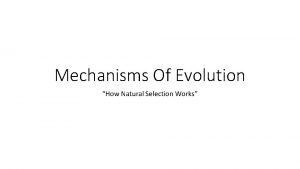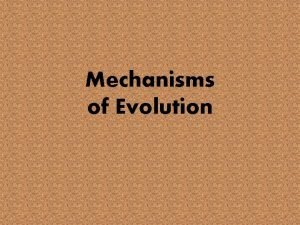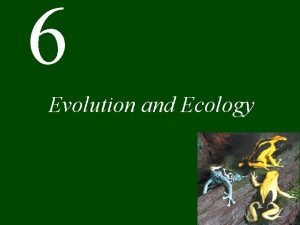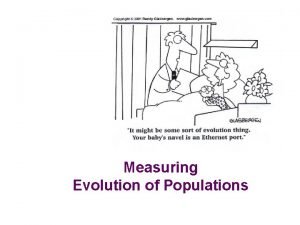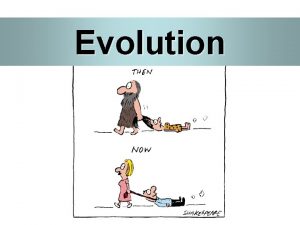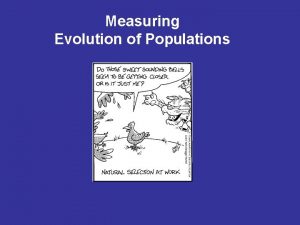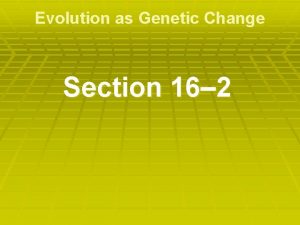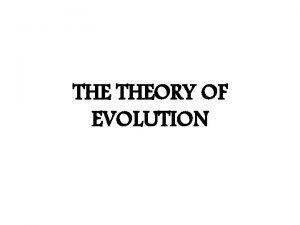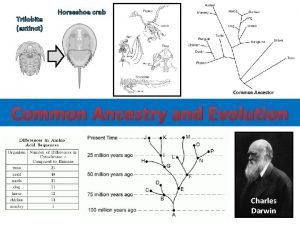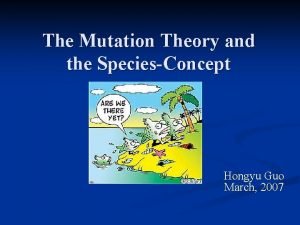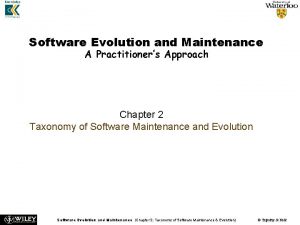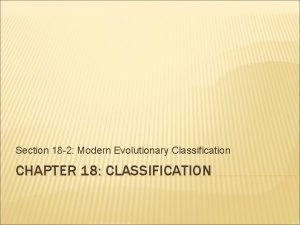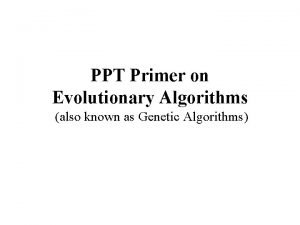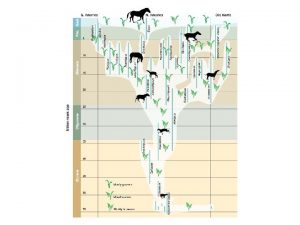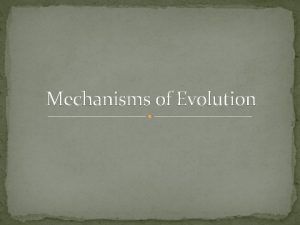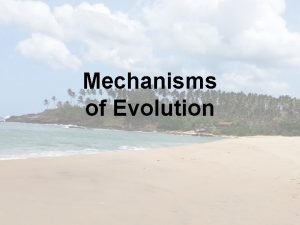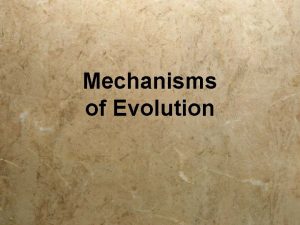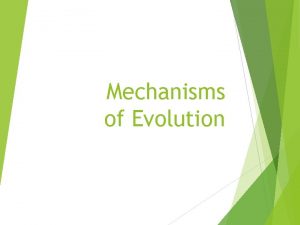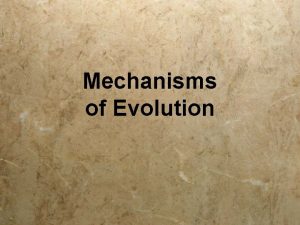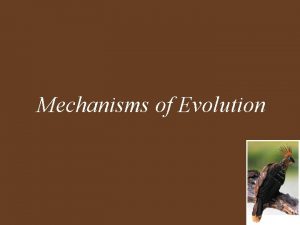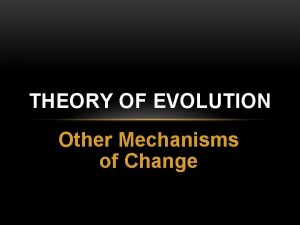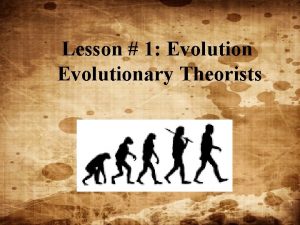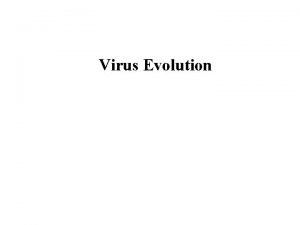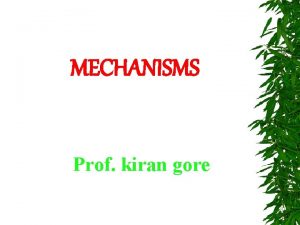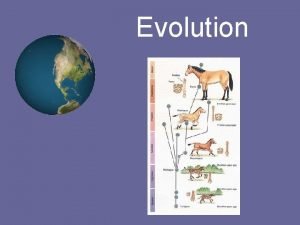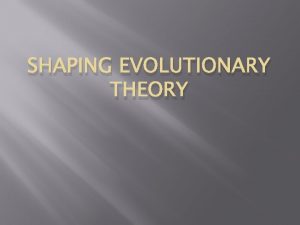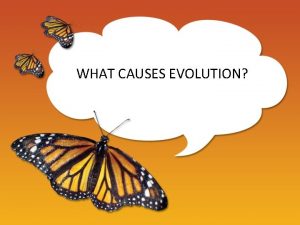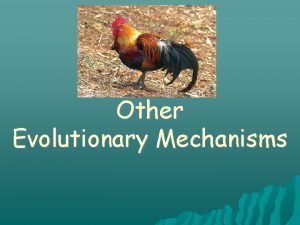Mechanisms of Evolutionary Change Evolution is defined as


























- Slides: 26

Mechanisms of Evolutionary Change • Evolution is defined as a change in the frequencies of alleles (Ex: A and a) in a population across generations. Changes in allele frequencies cause changes in genotype frequencies, which cause changes in phenotype frequencies. • Three major factors alter allele frequencies and bring about most evolutionary change • Natural selection • Genetic drift • Gene flow

Modes of Natural Selection: • Stabilizing • Favors the mean • Directional • Favors one phenotypic extreme • Disruptive • Favors two or more phenotypic extremes

Modes of selection (a) No selection (b) Stabilizing selection

Modes of selection (c) Directional selection (d) Disruptive selection

Genetic Drift: random allele frequency (gene pool) changes in SMALL populations due to chance alone (not natural selection) Genetic drift tends to reduce genetic variation through losses of alleles, especially in small populations Note: The gene pool for a population is defined as all the alleles in a population and their frequencies Two factors that could cause a drastic reduction in the size of a population, which would result in an increase in genetic drift: a) The Bottleneck Effect: When a natural disaster reduces the size of a population and the survivors are determined by chance (Ex: flood or overhunting)

• B) The Founder Effect: The founder effect occurs when a few individuals become isolated from a larger population • Allele frequencies in the small founder population can be different from those in the larger parent population due to chance(Ex: colonizing a new island)

• Gene flow consists of the movement of alleles among populations • Alleles can be transferred through the movement of fertile individuals or gametes (for example, pollen) • Gene flow tends to reduce genetic variation among populations over time

Macroevolution and Speciation Evolution creates (and destroys) new species, but … What is a species? Its not as straightforward a question as most believe. These are members of different species - eastern (left) and western (right) meadowlark.

What is a Species? And these are all members of a single species.

What is a Species? The definition we’ll use is this: A species is a group of individuals capable of interbreeding to produce fertile offspring. This is the biological species concept. Like all attempts to define a species, it has many problems.

How Many Species Are There? We don’t know. About 2 million species have been described. Estimates of existing species number range from 4 million to 100 million (with 10 -15 million being a more commonly considered upper estimate).

Speciation • A population becomes reproductively isolated • The separated gene pools diverge • Genetic exchange stops

How Do Species Arise? The key to speciation is reproductive isolation of populations. Geographic isolation is the primary extrinsic reproductive isolating mechanism.

Reproductive isolation can be classified by whether barriers act before or after fertilization: Prezygotic barriers block fertilization from occurring by Impeding different species from attempting to mate Preventing the successful completion of mating Hindering fertilization if mating is successful Postzygotic barriers prevent the hybrid zygote from developing into a viable, fertile adult by Reduced hybrid viability Reduced hybrid fertility Hybrid breakdown

Figure 22. 3 Prezygotic barriers Habitat isolation Temporal isolation Behavioral isolation Mechanical isolation Postzygotic barriers Gametic isolation MATING ATTEMPT (a) (c) (d) (e) (f) Reduced hybrid viability Reduced Hybrid hybrid breakdown fertility VIABLE, FERTILE OFFSPRING FERTILIZATION (g) (h) (i) (j) (b) (k) (l)

*Reproductive Isolation May Occur With or Without Geographic Isolation* Allopatric speciation occurs when geographic isolation creates a reproductive barrier Sympatric speciation occurs when a reproductive barrier is created by something other than geographic isolation

Allopatric speciation • Geographically separated populations • Most common form of speciation • Genetic drift in small populations

Allopatric Speciation Harris’ antelope squirrel White-tailed antelope squirrel Two species of ground squirrel are postulated to have descended from a common ancestral population that was separated by formation of the Grand Canyon.

Squirrel species separated by the Grand Canyon have diverged in fur color

Sympatric speciation • Divergence of two populations in the same geographic region • Other reproductive isolating mechanisms at work • Especially common in plants

Sympatric speciation in animals • Population occupies a new ecological niche • No gene flow even though species live in the same area

Speciation Occurs at Widely Differing Rates A slow rate of speciation evidenced by a living horseshoe crab (13 extant species) and a 300 million year-old fossil species A rapid rate of speciation evidenced by Galapagos finches which have diversified into 13 species within the last 100, 000 years. Generalists, like the horseshoe crab, tend to remain as stable species. Specialists, like the Galapagos finch, tend to be unstable as species. Speciation also becomes rapid when, as occurred with Galapagos finches, new niches become available.

Punctuated equilibrium • • Long periods of stasis (~2 My) Punctuated by periods of rapid speciation (~100, 000 y) Triggered by changes in the environment Abrupt appearance of new species in the fossil record

Gradualism • • Continuous evolution over long periods The traditional view Populations gradually accumulate adaptations Different selective pressures in different environments

Speciation Dynamics - Gradualism or Punctuated Equilibrium? Punctuated equilibrium appears to be a more accurate view of speciation dynamics.

Adaptive radiation • Speciation fills new ecological niches • New adaptive zones may appear when the environment changes • One species colonizes an island diversifies into new species
 Mechanisms of evolution
Mechanisms of evolution Chapter 15 section 3 shaping evolutionary theory
Chapter 15 section 3 shaping evolutionary theory What are the mechanisms of evolution
What are the mechanisms of evolution Hemoglobin c
Hemoglobin c Mechanisms of evolution
Mechanisms of evolution Mechanisms of evolution
Mechanisms of evolution Mechanisms of evolution
Mechanisms of evolution Natural selection graphic organizer
Natural selection graphic organizer Detecting evolutionary forces in language change
Detecting evolutionary forces in language change 5 agents of evolutionary change
5 agents of evolutionary change 5 agents of evolutionary change
5 agents of evolutionary change Well defined and not well defined sets
Well defined and not well defined sets 16-2 evolution as genetic change
16-2 evolution as genetic change Industry evolution and strategic change
Industry evolution and strategic change Model of evolution showing slow change
Model of evolution showing slow change Evolutionary perspective of psychology
Evolutionary perspective of psychology Vuzzer: application-aware evolutionary fuzzing
Vuzzer: application-aware evolutionary fuzzing Horseshoe crab evolutionary tree
Horseshoe crab evolutionary tree Modern evolutionary synthesis
Modern evolutionary synthesis Five factors of evolution
Five factors of evolution Evolutionary maintenance
Evolutionary maintenance Evolutionary software process models
Evolutionary software process models 18-2 modern evolutionary classification
18-2 modern evolutionary classification Evolutionary computing ppt
Evolutionary computing ppt Taxa biology
Taxa biology The term extrinsic motivation refers to reasons to act that
The term extrinsic motivation refers to reasons to act that Evolutionary theory of motivation
Evolutionary theory of motivation
